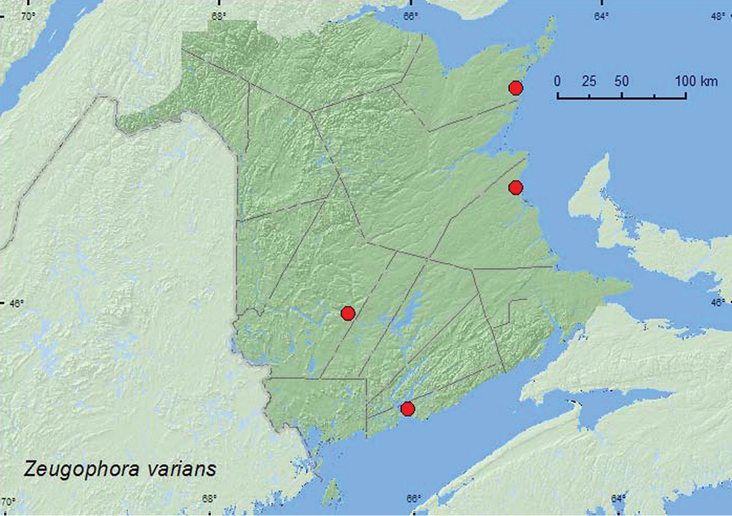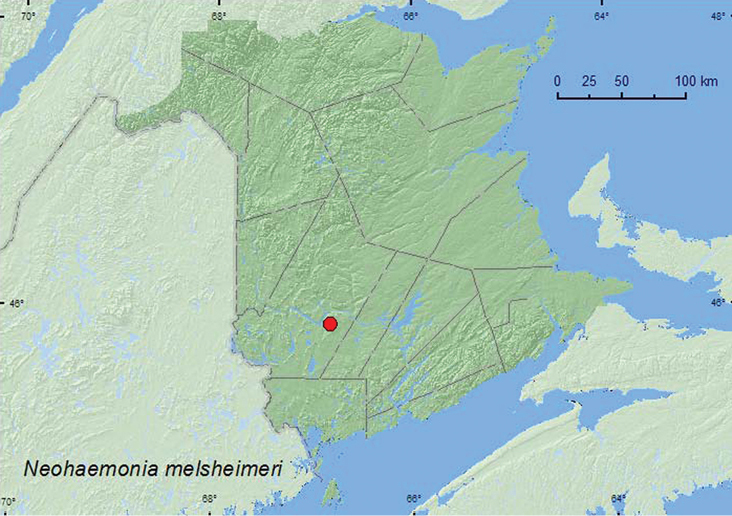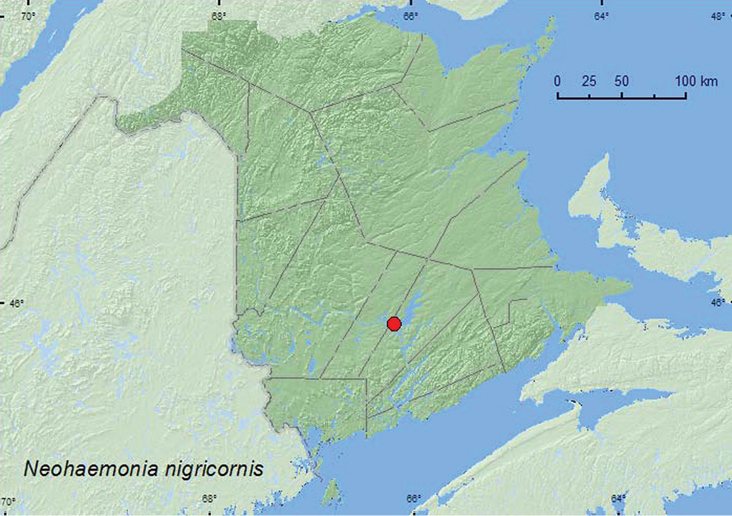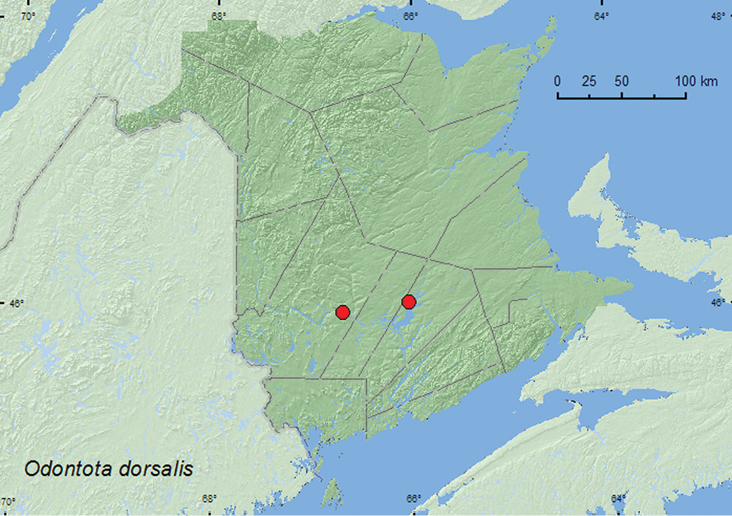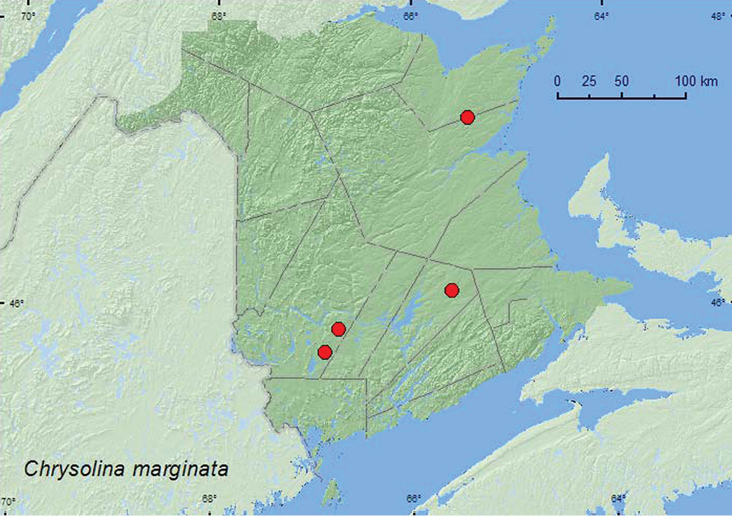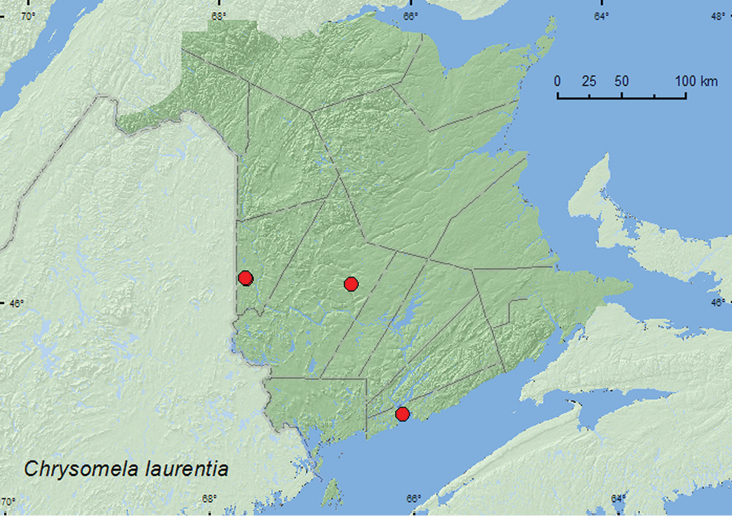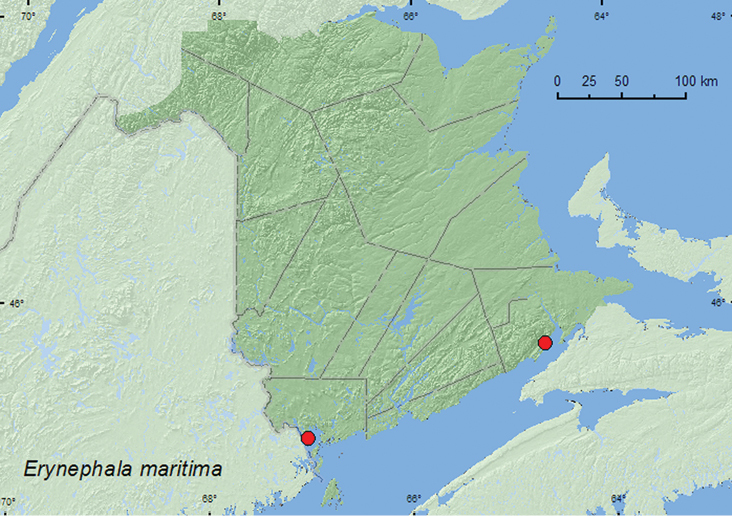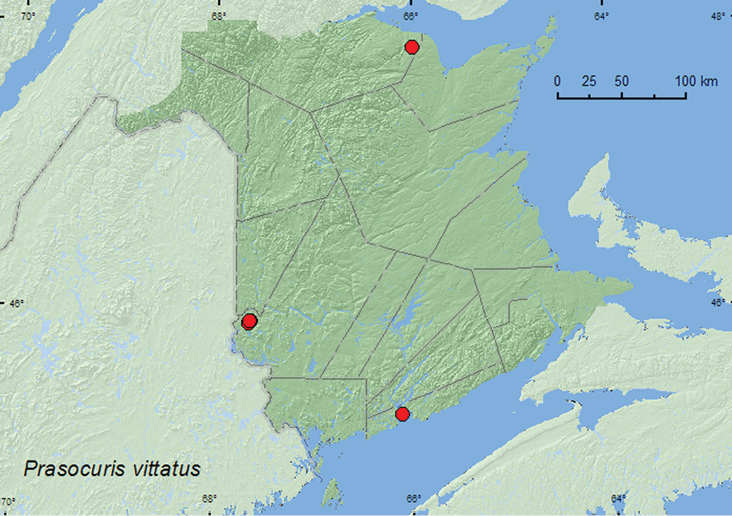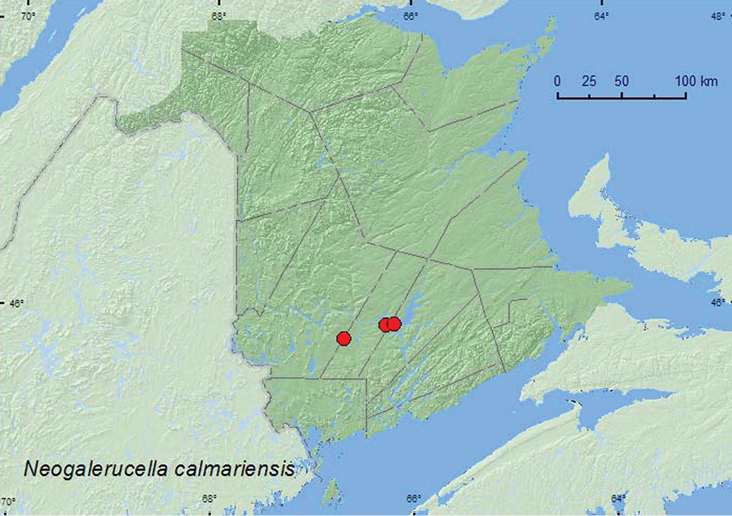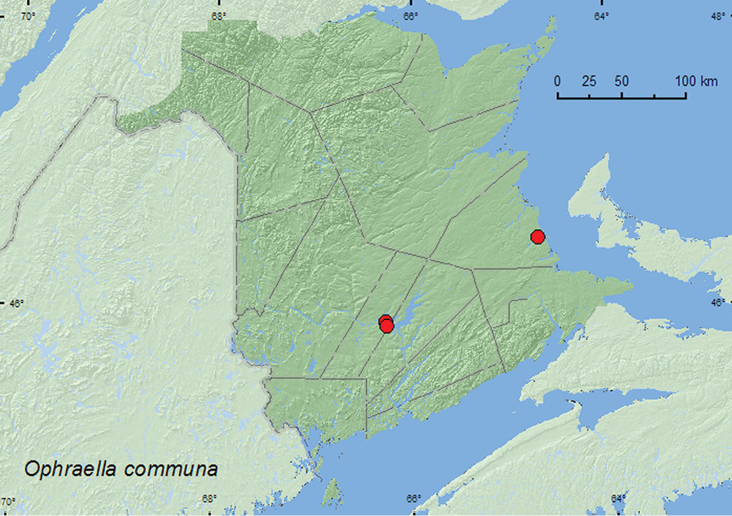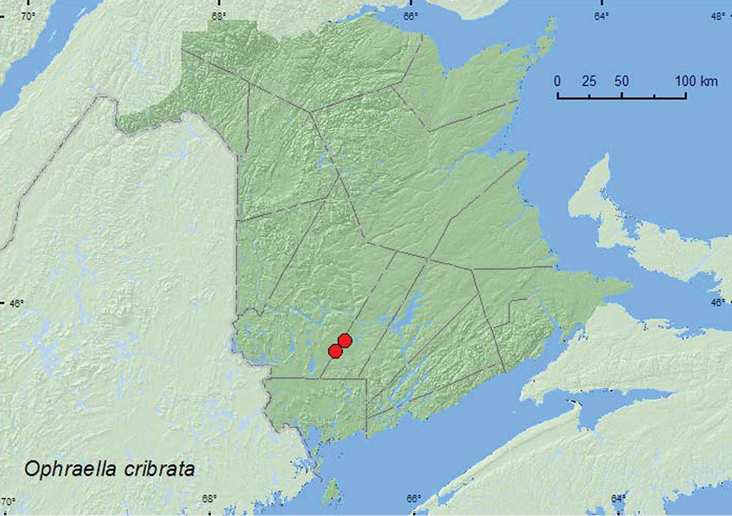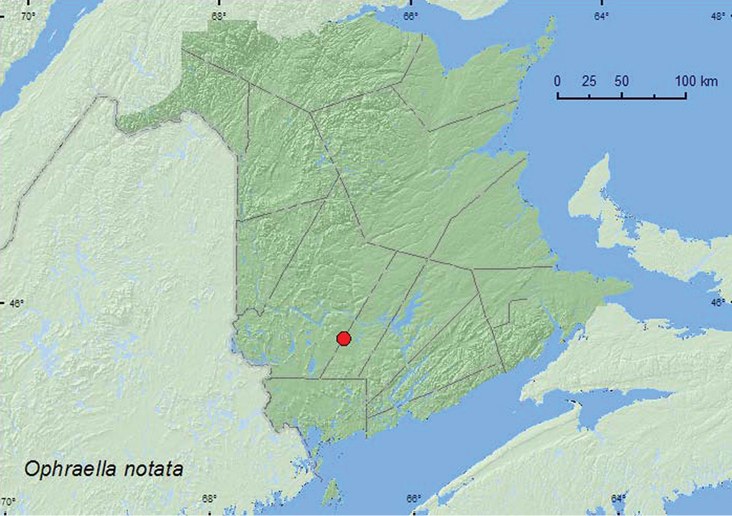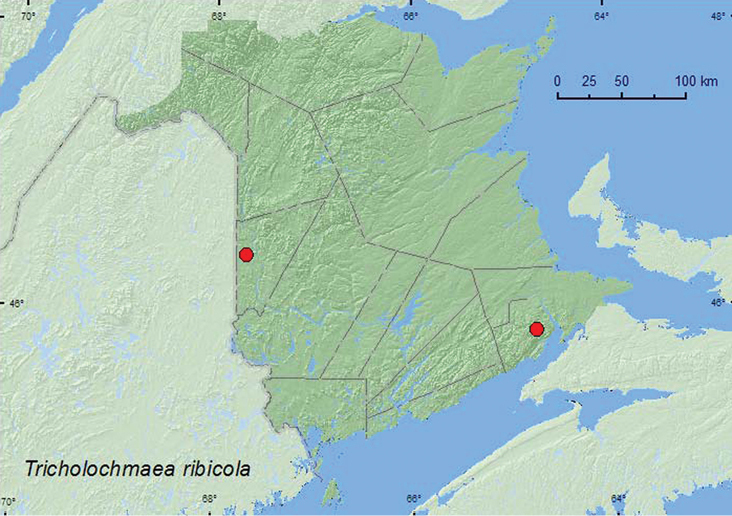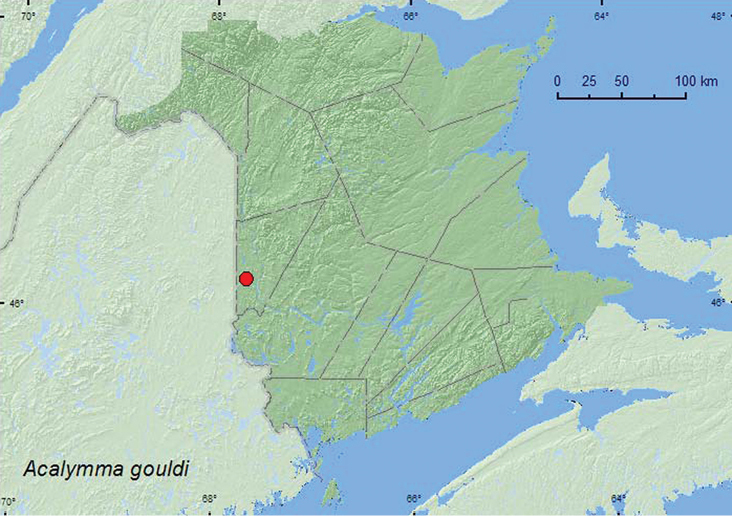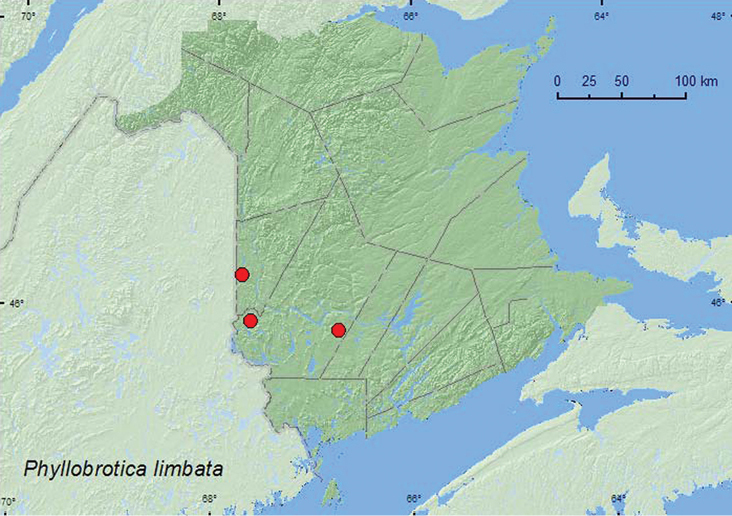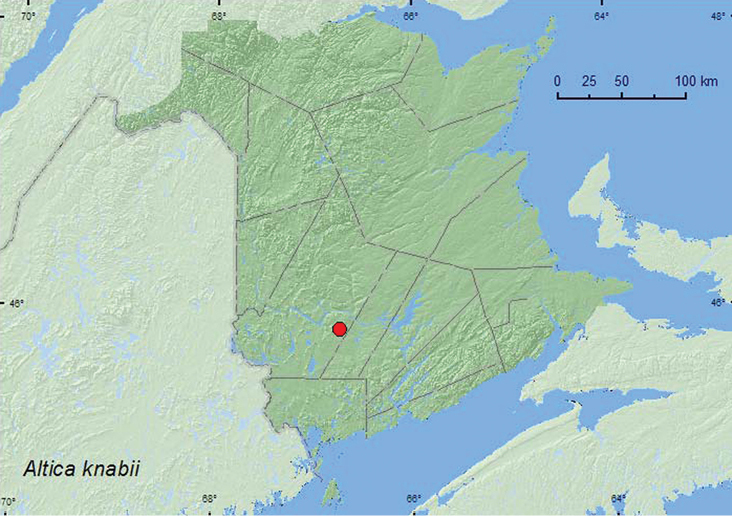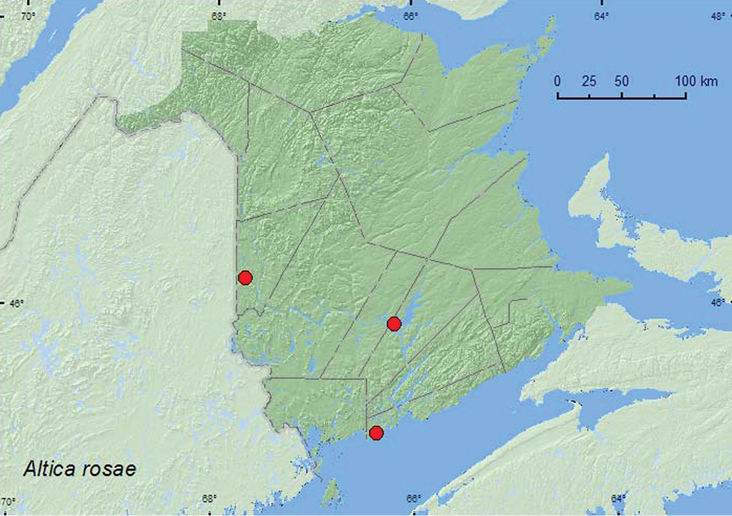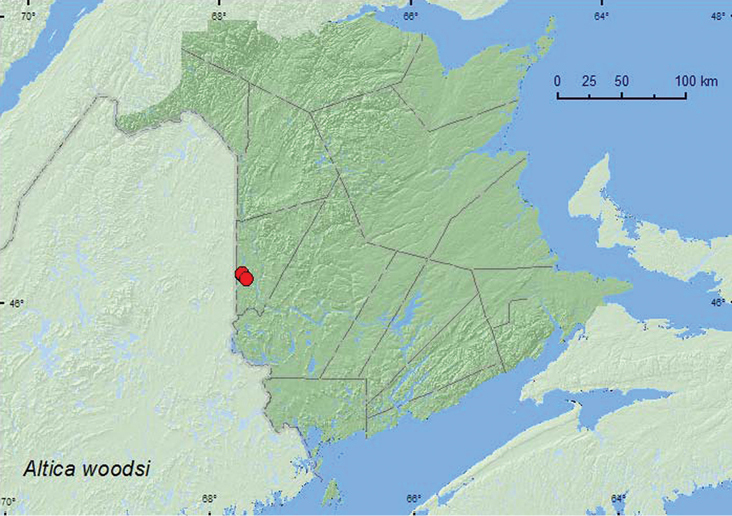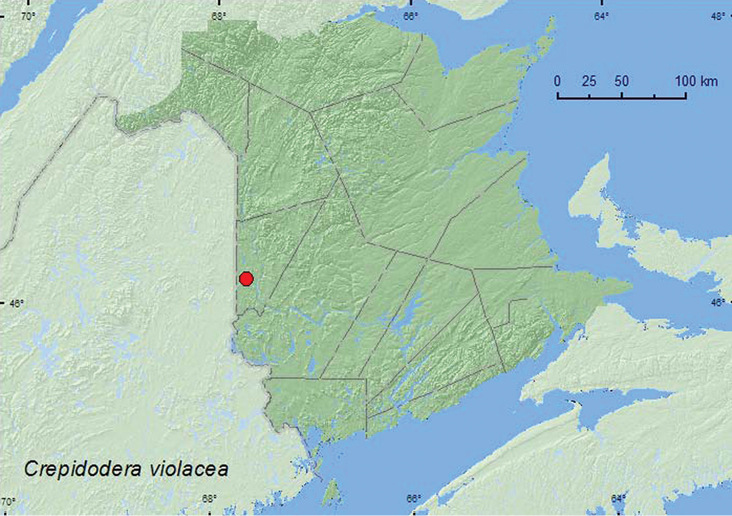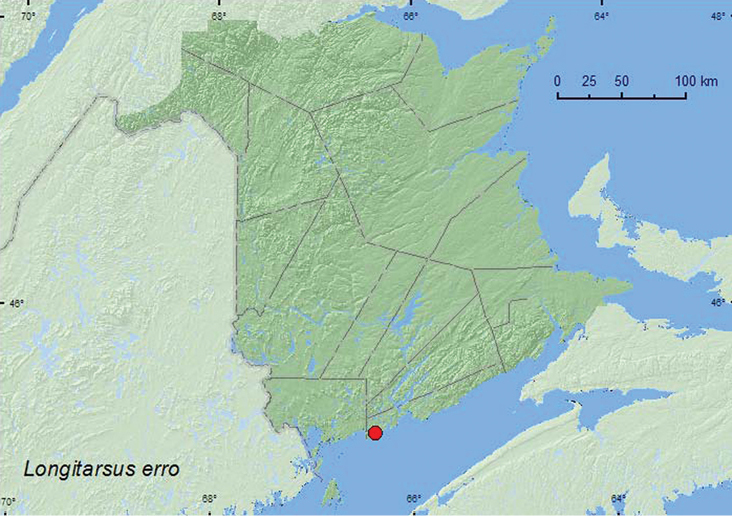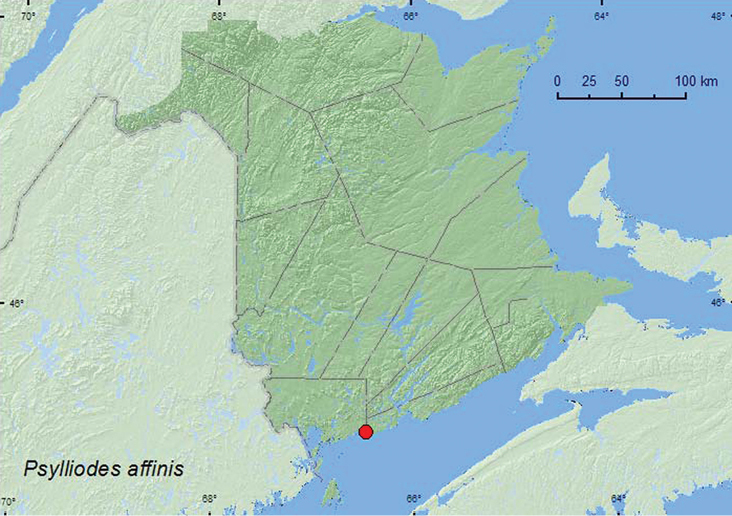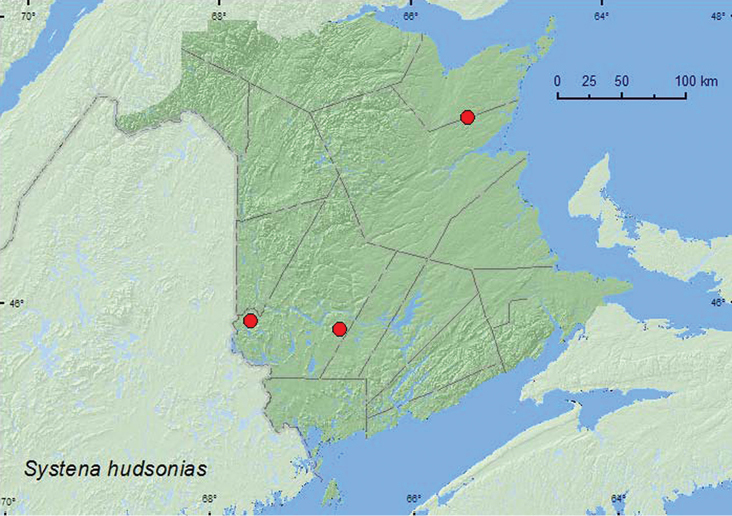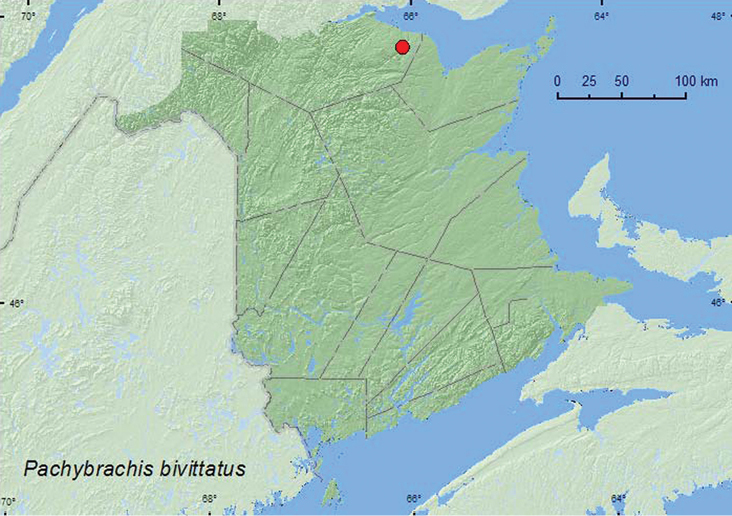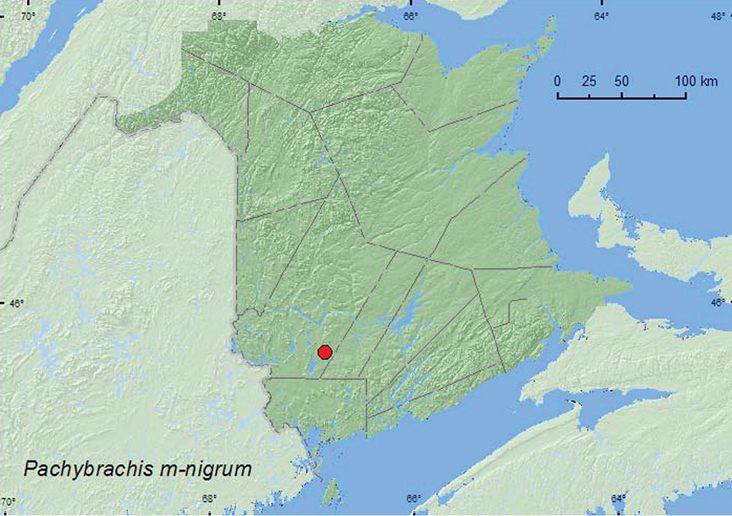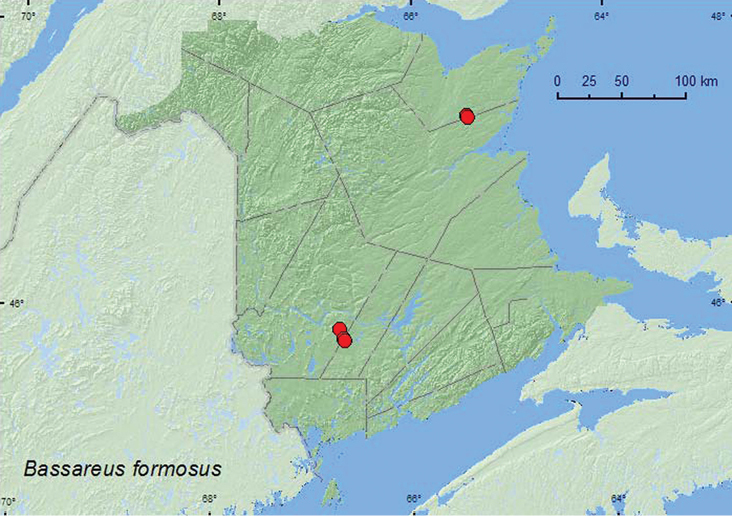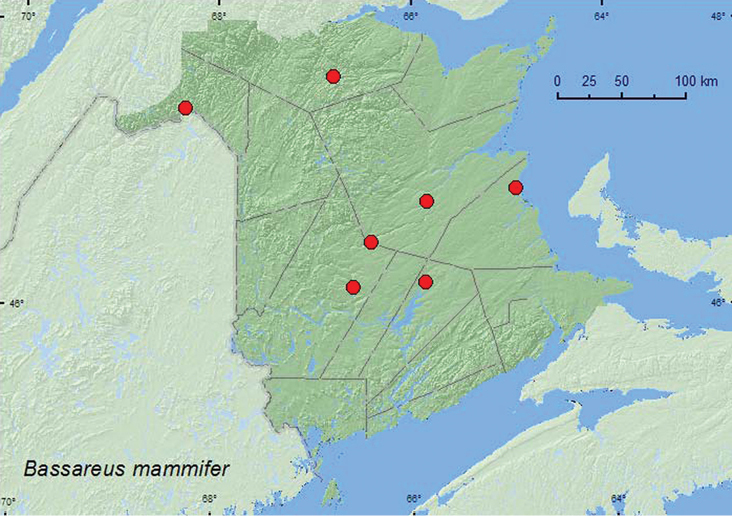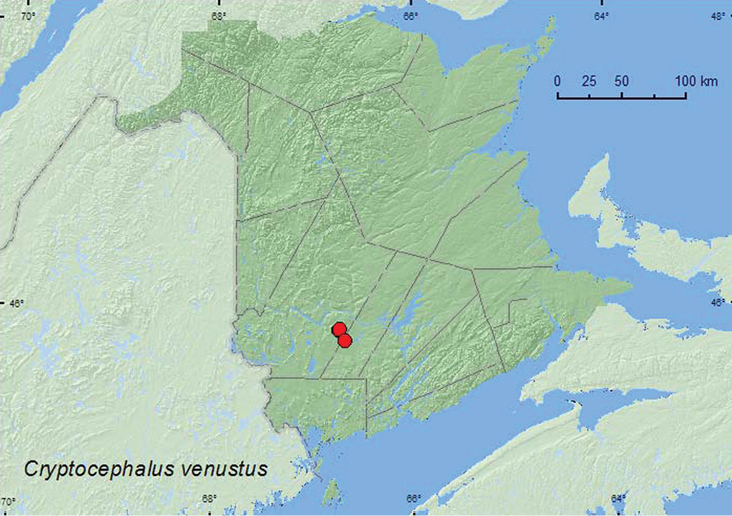






(C) 2012 Reginald P. Webster. This is an open access article distributed under the terms of the Creative Commons Attribution License 3.0 (CC-BY), which permits unrestricted use, distribution, and reproduction in any medium, provided the original author and source are credited.
For reference, use of the paginated PDF or printed version of this article is recommended.
Zeugophora varians Crotch and the family Megalopodidae are newly recorded for New Brunswick, Canada. Twenty-eight species of Chrysomelidae are newly recorded for New Brunswick, including Acalymma gouldi Barber, Altica knabii Blatchley, Altica rosae Woods, Altica woodsi Isely, Bassareus mammifer (Newman), Chrysolina marginata (Linnaeus), Chrysomela laurentia Brown, Crepidodera violacea Melsheimer, Cryptocephalus venustus Fabricius, Neohaemonia melsheimeri (Lacordaire), Neohaemonia nigricornis (Kirby), Pachybrachis bivittatus (Say), Pachybrachis m-nigrum (Melsheimer), Phyllobrotica limbata (Fabricius), Psylliodes affinis (Paykull), Odontota dorsalis (Thunberg), Ophraella communa (LeSage), Ophraella cribrata (LeConte), Ophraella notata (Fabricius), Systena hudsonias (Forster), Tricholochmaea ribicola (Brown), and Tricholochmaea rufosanguinea (Say), which are also newly recorded for the Maritime provinces. Collection data, habitat data, and distribution maps are presented for all these species.
Chrysomelidae, Megalopodidae, new records, Canada, New Brunswick
This paper treats the families Chrysomelidae and Megalopodidae. The Megalopodidae (megalopodid leaf beetles), historically considered a subfamily of Chrysomelidae (
The Chrysomelidae (the leaf beetles) is one of the largest families of beetles. The Chrysomelidae, as the common name implies, are phytophagous and feed on leaves of plants, usually Angiospermae. Adults of most species are either monophagous or oligophagous and usually use terrestrial species, whereas the larvae have more diverse feeding habits. Donaciinae larvae are aquatic and live on submerged stems and roots of their host (
A few comments are required regarding Crepidodera digna Parry, Dibolia penstemonis Parry, and Diachus catarius (Suffrian) which were recorded from New Brunswick by
Intensive collecting by the first author and others since 2003 has resulted in the discovery of additional species of Chrysomelidae from New Brunswick (Table 1). Additional records were discovered in the older material preserved in the Canadian National Collection in Ottawa, including the first record of the family Megalopodidae. The purpose of this paper is to report on these new discoveries.
Methods and conventionsThe following records are based in part on specimens collected as part of a general survey by the first author to document the Coleoptera fauna of New Brunswick. A description of the habitat was recorded for all specimens collected during this survey. Locality and habitat data are presented exactly as on labels for each record. This information, as well as additional collecting notes, is summarized and discussed in the collection and habitat data section for each species.
Collection methodsMost specimens were collected by sweeping vegetation in various habitats, and beating, sweeping, or hand picking beetles from host plants. Additional records were obtained from specimens contained in the collection belonging to Natural Resources Canada, Canadian Forest Service - Atlantic Forestry Centre, Fredericton, New Brunswick and the Canadian National collection, Ottawa, Ontario.
Specimen preparationMales and females of some species were dissected to confirm their identity. Male aedeagi were dissected in 70% ethanol and glued on tip of small points under the specimens from which they originated. The female genital structures were dissected in 70% ethanol, dehydrated in absolute alcohol, transferred into cedar oil, and mounted in Canada balsam on small transparent acetate cards pinned with the specimens from which they originated.
DistributionDistribution maps, created using ArcMap and ArcGIS, are presented for each species in New Brunswick. Every species is cited with current distribution in Canada and Alaska, using abbreviations for the state, provinces, and territories. New records for New Brunswick are indicated in bold under Distribution in Canada and Alaska. The following abbreviations are used in the text:
| AK | Alaska | MB | Manitoba |
| YT | Yukon Territory | ON | Ontario |
| NT | Northwest Territories | QC | Quebec |
| NU | Nunavut | NB | New Brunswick |
| BC | British Columbia | PE | Prince Edward Island |
| AB | Alberta | NS | Nova Scotia |
| SK | Saskatchewan | NF & LB | Newfoundland and Labrador |
Acronyms of collections examined or where specimens reside referred to in this study are as follows:
AFC Atlantic Forestry Centre, Natural Resources Canada, Canadian Forest Service, Fredericton, New Brunswick, Canada
CGMC Christopher G. Majka Collection, Halifax, Nova Scotia, Canada
CNC Canadian National Collection of Insects, Arachnids, and Nematodes, Agriculture and Agri-Food Canada, Ottawa, Ontario, Canada
NBM New Brunswick Museum, Saint John, New Brunswick, Canada
RWC Reginald P. Webster Collection, Charters Settlement, New Brunswick, Canada
UMNB Université de Moncton Collection, Moncton, New Brunswick, Canada
Results Species accountsAll records below are species newly recorded for New Brunswick, Canada. Species followed by ** are newly recorded from the Maritime provinces of Canada.
The classification of the Chrysomelidae and Megalopodidae follows
Species of Megalopodidae and Chrysomelidae recorded from New Brunswick, Canada.
| Family Megalopodidae Latreille |
| Subfamily Zeugophorinae Böving & Craighead |
| Zeugophora varians Crotch** |
| Family Chrysomelidae Latreille |
| Subfamily Donaciinae Kirby |
| Tribe Plateumarini Askevold |
| Plateumaris balli Askevold |
| Plateumaris flavipes (Kirby) |
| Plateumaris frosti (Schaeffer) |
| Plateumaris fulvipes (Lacordaire) |
| Plateumaris germari (Mannerheim) |
| Plateumaris metallica (Ahrens) |
| Plateumaris nitida (Germar) |
| Plateumaris pusilla (Say) |
| Plateumaris rufa (Say) |
| Plateumaris shoemakeri (Schaeffer) |
| Tribe Donaciini Kirby |
| Donacia palmata (Olivier) |
| Donacia piscatrix Lacordaire |
| Donacia proxima Kirby |
| Donacia caerulea Olivier |
| Donacia confluenta Say |
| Donacia fulgens LeConte |
| Donacia hirticollis Kirby |
| Donacia magnifica J. L. LeConte |
| Donacia subtilis Kunze |
| Donacia tuberculifrons Schaeffer |
| Tribe Haemoniini Chen |
| Neohaemonia melsheimeri (Lacordaire)** |
| Neohaemonia nigricornis (Kirby)** |
| Subfamily Criocerinae Latreille |
| Tribe Criocerini Latreille |
| Crioceris asparagi (Linnaeus) |
| Crioceris duodecimpunctata (Linnaeus) |
| Lilioceris lilii (Scopoli) |
| Tribe Lemini Heinzen |
| Lema puncticollis Curtis |
| Oulema melanopus (Linnaeus) |
| Subfamily Cassidinae Gyllenhal |
| Tribe Chalepini Weise |
| Anisostena nigrita (Olivier) |
| Baliosus nervosus (Panzer) |
| Glyphuroplata pluto (Newman) |
| Microrhopala excavata excavata (Olivier) |
| Microrhopala vittata (Fabricius) |
| Microrhopala xerene (Newman) |
| Odontota dorsalis (Thunberg)** |
| Sumitrosis inaequalis (Weber) |
| Sumitrosis rosea (Weber) |
| Tribe Cassidiini Gyllenhal |
| Cassida rubiginosa Müller |
| Charidotella purpurata (Boheman) |
| Charidotella sexpunctata bicolor (Fabricius) |
| Deloyala guttata (Olivier) |
| Plagiometriona clavata clavata (Fabricius) |
| Subfamily Chrysomelinae Latreille |
| Tribe Chrysomelini Latreille |
| Subtribe Gonioctenina Motschulski |
| Gonioctena americana (Schaeffer) |
| Subtribe Doryphorina Motschulski |
| Chrysolina hyperici hyperici (Forster) |
| Chrysolina marginata (Linnaeus)** |
| Chrysolina quadrigemina (Suffrian) |
| Calligrapha bidenticola Brown |
| Calligrapha californica coreopsivora Brown |
| Calligrapha alni Schaeffer |
| Calligrapha alnicola Brown |
| Calligrapha confluens Schaeffer |
| Calligrapha ignota Brown |
| Calligrapha multipunctata (Say) |
| Calligrapha philadelphica (Linnaeus) |
| Calligrapha rowena Knab |
| Calligrapha tiliae Brown |
| Calligrapha vicina Schaeffer |
| Calligrapha virginea Brown |
| Calligrapha lunata (Fabricius) |
| Labidomera clivicollis (Kirby) |
| Leptinotarsa decemlineata (Say) |
| Subtribe Chrysomelina Latreille |
| Chrysomela crotchi Brown |
| Chrysomela laurentia Brown** |
| Chrysomela lineatopunctata Forster |
| Chrysomela mainensis mainensis J. Bechyné |
| Gastrophysa polygoni (Linnaeus) |
| Phaedon armoraciae armoraciae (Linnaeus) |
| Phaedon laevigatus (Duftschmid) |
| Phaedon oviformis (LeConte) |
| Phaedon viridis Melsheimer |
| Phratora americana canadensis Brown |
| Phratora purpurea purpurea Brown |
| Plagiodera versicolora (Laicharting) |
| Prasocuris vittata (Olivier)* |
| Subfamily Galerucinae Latreille |
| Tribe Galerucini Latreille |
| Erynephala maritima (LeConte)* |
| Galerucella nymphaeae (Linnaeus) |
| Neogalerucella calmariensis (Linnaeus)* |
| Neogalerucella pusilla (Duftschmid) |
| Ophraella conferta (LeConte) |
| Ophraella communa (LeSage)** |
| Ophraella cribrata (LeConte)** |
| Ophraella notata (Fabricius)** |
| Pyrrhalta viburni (Paykull) |
| Tricholochmaea alni (Fall) |
| Tricholochmaea cavicollis ( LeConte) |
| Tricholochmaea decora decora (Say) |
| Tricholochmaea kalmiae (Fall) |
| Tricholochmaea perplexa (Fall) |
| Tricholochmaea ribicola (Brown)** |
| Tricholochmaea rufosanguinea (Say)** |
| Tricholochmaea tuberculata (Say) |
| Tricholochmaea vaccinii (Fall) |
| Trirhabda borealis Blake |
| Trirhabda canadensis (Kirby) |
| Trirhabda virgata LeConte |
| Xanthogaleruca luteola (Müller) |
| Tribe Luperini Chapuis |
| Subtribe Diabroticina Chapuis |
| Acalymma vittatum (Fabricius) |
| Acalymma gouldi Barber** |
| Diabrotica barberi R. Smith & Lawrence |
| Subtribe Luperina Chapuis |
| Phyllobrotica decorata (Say) |
| Phyllobrotica limbata (Fabricius)** |
| Scelolyperus cyanellus (LeConte) |
| Scelolyperus meracus (Say) |
| Tribe Alticini Newman |
| Altica ambiens alni Harris |
| Altica browni Mohamedsaid |
| Altica carinata Germar |
| Altica corni Woods |
| Altica kalmiae (Melsheimer) |
| Altica knabii Blatchley** |
| Altica prasina populi Brown |
| Altica rosae Woods** |
| Altica sylvia Malloch |
| Altica tombacina Mannerheim |
| Altica ulmi Woods |
| Altica woodsi Isely** |
| Capraita subvittata (Horn) |
| Chaetocnema borealis White |
| Chaetocnema concinna (Marsham) |
| Chaetocnema confinis Crotch |
| Chaetocnema minuta Melsheimer |
| Chaetocnema protensa LeConte |
| Crepidodera heikertingeri (Lazorko) |
| Crepidodera luminosa Parry |
| Crepidodera nana (Say) |
| Crepidodera populivora Parry |
| Crepidodera violacea Melsheimer** |
| Dibolia borealis Chevrolat |
| Dibolia melampyri Parry |
| Disonycha alternata (Illiger) |
| Disonycha latifrons Schaeffer |
| Disonycha xanthomelas (Dalman) |
| Distigmoptera borealis Blake |
| Distigmoptera impennata Blake |
| Epitrix cucumeris (Harris) |
| Kuschelina vians (Illiger) |
| Longitarsus erro Horn* |
| Longitarsus jacobaeae (Waterhouse) |
| Longitarsus luridus (Scopoli) |
| Longitarsus testaceus (Melsheimer) |
| Mantura chrysanthami (Koch)* |
| Phyllotreta armoraciae (Koch) |
| Phyllotreta cruciferae (Goeze) |
| Phyllotreta robusta LeConte |
| Phyllotreta striolata (Fabricius) |
| Phyllotreta zimmermanni (Crotch) |
| Psyliodes affinis (Paykull)** |
| Psyliodes cucullatus (Illiger) |
| Psyliodes napi (Fabricius) |
| Psyliodes punctulatus Melsheimer |
| Systena frontalis (Fabricius) |
| Systena hudsonias (Forster)** |
| Subfamily Eumolpinae Hope |
| Tribe Synetini |
| Syneta extorris borealis Brown |
| Syneta ferruginea (Germar) |
| Syneta pilosa Brown |
| Tribe Adoxini Baly |
| Bromius obscurus (Linnaeus) |
| Xanthonia decemnotata (Say) |
| Subfamily Cryptocephalinae Gyllenhal |
| Tribe Cryptocephalini Gyllenhal |
| Subtribe Pachybrachina Chapuis |
| Pachybrachis bivittatus (Say)** |
| Pachybrachis m-nigrum (Melsheimer)** |
| Pachybrachis peccans Suffrian |
| Pachybrachis pectoralis (Melsheimer) |
| Subtribe Monachulina Leng |
| Lexiphanes saponatus (Fabricius) |
| Subtribe Cryptocephalina Gyllenhal |
| Bassareus formosus (Melsheimer)* |
| Bassareus mammifer (Newman)** |
| Cryptocephalus gibbicollis gibbiciollis Haldeman |
| Cryptocephalus notatus Fabricius |
| Cryptocephalus venustus Fabricius** |
| Diachus auratus (Fabricius) |
| Triachus vacuus LeConte |
| Tribe Chlamisini Gressitt |
| Exema canadensis Pierce |
| Neochlamisus comptoniae (Brown) |
| Neochlamisus cribripennis (J. L. LeConte) |
| Neochlamisus eubati (Brown) |
| Neochlamisus fragariae (Brown) |
New Brunswick, Gloucester Co., Tracadie, 30.VII.1939, W. J. Brown (1, CNC). Kent Co., Kouchibouguac National Park, 5.VII.1977, S. J. Miller, 5786N (1, CNC); same locality, collector, and date, 5487A (1, CNC); same locality and collector, 9.VIII.1977, 5805B (1, CNC); same locality and collector, 16.VIII.1977, 6054V (2, CNC). Saint John Co., Saint John, Rockwood Park, 7.VIII.1953, J. F. Brimley (1, CNC). York Co. Fredericton, 16.VII.1928, W. J. Brown (4, CNC).
No bionomic data were associated with the specimens. This species has been recorded from Populus balsmifera L., Populus tremuloides Michx. and Salix (
New Brunswick, York Co., Mazerolle Settlement, 45.8765°N, 66.8260°W, 8.VI.2008, R. P. Webster, beaver meadow, sweeping vegetation along brook margin (1, RWC).
This species has been collected from leaves and stems of pondweeds (Potamogeton sp.) (Potamogetonaceea) (
New Brunswick, Queens Co., Scotchtown at Grand Lake, 45.8760°N, 66.1816°W, 25.VI.2003, R. P. Webster, lake margin, on foliage.
This species has been collected from leaves and stems of pondweeds (Potamogeton sp.) (
New Brunswick, Queens Co., Canning, near Flowers Cove off Rt. 960, 46.0363°N, 66.0387°W, 1.VII.2004, D. Sabine & R. Webster, on foliage of Robinia pseudoacacia L. (14, CNC, NBM, RWC). York Co., Fredericton, 23.IX.2009, C. Maund, on apple trees (1, CNC).
In New Brunswick, adults were collected from foliage of black locust(Robinia pseudoacacia L.) in early July. One individual was collected from an apple (Malus pumilla P. Mill.) tree. Larvae mine the leaves of black locust and other woody species of Fabaceae. Adults also feed on black locust and other Fabaceae but have been collected from many other tree species (
New Brunswick, Queens Co., Cranberry Lake P.N.A. (Protected Natural Area), 46.1125°N, 65.6075°W, 18.VI.2009, R. Webster & M.-A. Giguère, red oak forest, sweeping foliage (in area with Leucanthemum vulgare Lam.) (1, AFC). Northumberland Co., Blueberry Rd. off Hwy 8, 47.3211°N, 65.4223°W, 29.VI.2007, R. P. Webster, jack pine forest with black spruce, on Leucanthemum vulgare Lam. (1, CNC, RWC). York Co., New Maryland, 45–50.50°N, 66–43.93°W, 5.IX.2002, R. P. Webster (1, CNC). Charters Settlement, 45.8395°N, 66.7391°W, 20.X.2004, 20.X.2004, 26.IX.2005, 21.X.2005, 28.IX.2006, R. P. Webster, (on pavement of street) (1, CNC, 2, RWC); 15.0 km W of Tracy off Rt. 645, 45.6837°N, 66.8809°W, 16.VI.2007, R. P. Webster, red pine forest, on Leucanthemum vulgare Lam. (1, CNC, 1, RWC).
Adults from New Brunswick were collected from the foliage of Leucanthemum vulgare Lam. (ox-eye-daisy) in open disturbed roadside sites near a red pine (Pinus resinosa Ait.) and a jack pine (Pinus banksiana Lamb.) forest. Specimens were also collected in the late fall on a paved road during warm afternoons. Adults were collected during June, September, and October.
AK, YT, NB (
Chrysolina finitima Brown, 1962 was placed in synonymy with Chrysolina marginata marginata (Linnaeus) by Bieńkowski (2001: 152), a synonymy accepted by
Collection localities in New Brunswick, Canada of Chrysolina marginata.
New Brunswick, Carleton Co., Meduxnekeag Valley Nature Preserve, 46.1890°N, 67.6766°W, 1.VIII.2004, V. Webster & R. Webster, river margin, sweeping foliage (1, RWC); same locality but 46.1931°N, 67.6825°W, 8.VI.2005, M.-A. Giguère & R. Webster, floodplain forest, sweeping (1, RWC); same locality data, 25.VI.2007, R. P. Webster, forest near river margin, beating foliage of Salix sp. (1, RWC). York Co., 1.5 km S of Taymouth, 46.1582°N, 66.6134°W, 15.VI.2006, R. P. Webster, Nashwaak River, on sand bar, on Salix sp. foliage (2, RWC). Saint John Co., Saint John, 9.VI.1901, W. McIntosh (1, NBM); Saint John, VII.1901, W. McIntosh (1, NBM).
The main host plants of Chrysolina laurentia are Salix sp., with known preferences for Salix discolor Mühl., Salix interior Mühl, Salix lucida Mühl., and Salix petiolaris J.E. Smith (
New Brunswick, Restigouche Co., Jacquet River Gorge P.N.A., 47.8160°N, 65.9928°W, 25.VI.2008, R. P. Webster, mixed forest, sweeping roadside foliage (2, RWC). Saint John Co., Saint John, VI.190?, W. McIntosh (1, NBM). York Co., Canterbury, 45.8841°N, 67.6428°W, 8.VI.2004, D. Sabine & R. Webster, hardwood forest, sweeping foliage of small marsh (sedges) (1, RWC); same locality but 45.8972°N, 67.6272°W, 21.VII.2004, D. Sabine, J. Edsall, K. Bredin, & R. Webster, mixed forest with cedar, sweeping foliage near small stream (2, RWC); Canterbury, Browns Mtn. Fen, 45.8977°N, 67.6335°W, 1.VI.2005, M.-A. Giguère & R. Webster, mixed forest, sweeping foliage along forest trail (5, RWC).
Prasocuris vittatus was collected by sweeping foliage along a roadside and forest trail, in a small marsh with Carex, and near a small stream. However, the true host is probably buttercup (Ranunculus acris L.) on which both larvae and adults were found and reared by the second author. Ranunculus acris and Ranunculus repens L. (Creeping buttercup) were reported as hosts for this species by
New Brunswick, Albert Co., Mary’s Point, 20.VIII.2005, C. G. Majka, salt marsh (5, CGMC). Charlotte Co., St. Andrews, 45.0751°N, 67.0374°W, 25.VIII.2006, R. P. Webster, sea beach, sweeping foliage (7, RWC).
Erynephala maritima was swept from foliage along a sea beach in August. According to
http://species-id.net/wiki/Neogalerucella_calmariensis
Map 9New Brunswick, Queens Co., Scotchtown near Indian Point, 45.8762°N, 66.1816°W, 5. VI.2004, 9.VII.2006, R. P. Webster, margin of lake, oak maple forest on sandy soil, sweeping foliage (6, NBM, RWC). Sunbury Co., about 2.0 km ESE of Gilbert Island at St. John River, 45.8712°N, 66.2705°W, 26.VI.2003, R. P. Webster, silver maple forest, sweeping vegetation near river margin (4, NBM, RWC); ca. 2.5 km S of Beaver Dam, 45.7735°N, 66.6852°W, 13.VIII.2008, R. P. Webster, power-line right of way, sweeping foliage of Alnus sp. (10, NBM, RWC).
Adults of this species were swept from foliage along a lake margin and a river margin. Adults were defoliating Alnus at the site south of Beaver Dam. This species was taken during June, July, and August.
BC, AB, MB, ON, NB, NS, PE (
Collection localities in New Brunswick, Canada of Neogalerucella calmariensis.
New Brunswick, Kent Co., Bouctouche, 20.VIII.1999, D. Audet (1, UMNB). Sunbury Co., Sheffield, Portobello Creek N.W.A., 45.8950°N, 66.2728°W, 4.VIII.2004, R. P. Webster, silver maple forest, on roadside ragweed (hand picking) (9, RWC); 3.0 km SE of McGowans Corner, 45.8677°N, 66.2590°W, 6.IX.2007, R. P. Webster, silver maple forest, sweeping roadside foliage near wet meadow (ragweed present) (1, RWC).
The host plant of Ophraella communa is common ragweed (Ambrosia artemisiifolia L.), and all life stages can be found on this plant (
New Brunswick, Sunbury Co., 9.5 km NE jct Rt. 101 & 645, 45.7586°N, 66.6755°W, 22.VII.2007, 29.VII.2007, 2.VII.2008, 30.VIII.2008, R. P. Webster, old field with open sandy areas, on Solidago sp. (9, RWC); 7.5 km W of Tracy off Rt. 645, 45.6861°N, 66.7719°W, 26.VI.2007, R. P. Webster, old field area near roadside, on Solidago sp. (1, RWC).
Host plants of Ophraella cribrata include the goldenrods, Solidago canadensis L. (as Solidago altissima L. in
New Brunswick, Sunbury Co., 2.5 km S of Beaver Dam, 45.7735°N, 66.6852°W, 13.VIII.2008, R. P. Webster, powerline-right-of-way, sweeping (and hand picking) foliage of Eupatorium perfoliatum (15, NBM, RWC).
The normal host plant of Ophraella notata is thoroughwort or bonset (Eupatorium perfoliatum L.)(
New Brunswick, Albert Co., Caledonia Gorge P.N.A., off Caledonia Mountain Rd., 45.8318°N, 64.7570°W, 1.VII.2011, R. P. Webster, small Carex marsh, on Ribes sp. (10, NBM, RWC). Carleton Co., Two Mile Brook Fen, 46.3594°N, 67.6800°W, 2.VI.2005, R. P. Webster, cedar swamp, on foliage of Ribes sp. (10, RWC).
The New Brunswick adults were taken on wild black currant (Ribes americanum P. Miller) during June and July.
http://species-id.net/wiki/Tricholochmaea_rufosanguinea
Map 14New Brunswick, York Co., Upper Brockway, 45.5684°N, 67.0993°W, 3.VI.2005, R. P. Webster, acid (blueberry) barrens, on foliage of Rhododendron canadense (10, RWC).
Adults were found on the foliage of rhodora (Rhododendron canadense (L.)) in a blueberry (Vaccinium sp.) barren during early June.
New Brunswick, Carleton Co., Meduxnekeag Valley Nature Preserve, 46.1888°N, 67.6762°W, 27.VIII.2007, R. P. Webster, upper river margin, sweeping foliage of Echinocystis lobata, prickly cucumber (4, RWC).
Specimens of this species were swept from the foliage ofprickly cucumber(Echinocystis lobata (Michx.) T. & G.) along an upper river margin during August.
New Brunswick, Carleton Co., Jackson Falls, Bell Forest, 46.2210°N, 67.7211°W, 1.VIII.2004, 13.VIII.2007, V. Webster & R. P. Webster, mature hardwood forest, sweeping foliage (2, RWC). Saint John Co., Saint John, 24.VII.1902, W. McIntosh (1, NBM). York Co., Canterbury, near Browns Mountain Fen, 45.8978°N, 67.6273°W, 3.VII.2005, M.-A. Giguère & R. Webster, mixed forest, on foliage of Corylus cornuta (1, RWC); Charters Settlement, 45.8331°N, 66.7410°W, 11.VIII.2007, 7.VII.2008, R. P. Webster, mature red spruce and red maple forest, sweeping foliage in shaded marshy area (3, RWC).
Specimens of this species were swept from foliage in a mature hardwood forest and in a shaded marshy area in a mature red spruce (Picea rubens Sarg.) and red maple (Acer rubrum L.) forest. One individual was collected from foliage of beaked hazelnut (Corylus cornuta Marsh.). Hosts reported by
New Brunswick, York Co., Charters Settlement, 45.8428°N, 66.7279°W, 28.IV.2004, R. P. Webster, mixed forest, in litter near small sedge marsh (1, RWC).
The only adult known from New Brunswick was sifted from leaf litter near a small Carex marsh during April. This was probably an overwintering site.
New Brunswick, Carleton Co., Wakefield, Meduxnekeag Valley Nature Preserve, 46.1931°N, 67.6825°W, 8.VI.2005, M.-A. Giguère & R. Webster, floodplain forest, on foliage of Rosa sp. (1, RWC). Queens Co., Grand Lake near Scotchtown, 45.8762°N, 66.1816°W, 3.VI.2007, R. P. Webster, oak / maple forest near lakeshore, sweeping foliage of Rosa sp. (1, RWC). Saint John Co., Chance Harbour, 45.1159°N, 66.3607°W, 30.V.2006, R. P. Webster, sea beach, on foliage of Rosa sp. (2, RWC).
All adults from New Brunswick were collected from the foliage of Rosa sp., a known host for this species (
New Brunswick, Carleton Co., Jackson Falls, Bell Forest, 46.2210°N, 67.7210°W, 12.VII.2004, K. Bredin, J. Edsall, & R. Webster, rich Appalachian hardwood forest, on foliage of Vitis riparia Michx. (4, RWC); same locality and collectors, 46.2252°N, 67.7190°W, 12.VII.2004, river margin, on foliage of Vitis riparia Michx. (2, NBM, RWC); same locality data, 1.VI.2005, M.-A. Giguère & R. Webster, river margin, on foliage of Vitis riparia Michx. (3, RWC); Meduxnekeag Valley Nature Preserve, 46.1925°N, 67.6725°W, 13.VII.2005, R. P. Webster, mixed forest, on foliage of Vitis riparia Michx. (1, RWC).
Altica woodsi was collected from the foliage of river bank or frost grape (Vitis riparia Michx.) in a rich Appalachian hardwood forest, a mixed forest, and along river margins in New Brunswick. Adults were collected during June and July. The Virginia creeper (Parthenocissus quinquefolia (L.) Planch.) is an alternate host used by both the larvae and adults (
New Brunswick, Carleton Co., Meduxnekeag Valley Nature Preserve, 46.1890°N, 67.6766°W, 8.VI.2005, M.-A. Giguère & R. Webster, flood plain forest, beating foliage of Prunus virginiana (10, RWC).
New Brunswick, Saint John Co., Dipper Harbour, 45.1169°N, 66.3771°W, 12. IX.2006, R. P. Webster, sea beach, sweeping vegetation (1, RWC).
One individual of this species was swept from foliage along a sea beach during September.
New Brunswick, Charlotte Co., near Maces Bay, 45.12447°N, 66.47346°W, 12.VIII.2007, R. P. Webster, barrier beach, sweeping vegetation (1, RWC). Northumberland Co., Blueberry Rd. off Hwy 8, 47.3211°N, 65.4229°W, 29.VI.2007, R. P. Webster, jack pine forest with black spruce, sweeping foliage of Rumex acetosella L. (4, RWC). Queens Co., Canning, Grand Lake near Scotchtown, 45.8762°N, 66.1816°W, 1.VII.2004, D. Sabine & R. Webster, lake shore, old dune with oaks, sweeping foliage (3, RWC). Sunbury Co., ca. 2.5 km S of Beaver Dam, 45.7703°N, 66.6867°W, 26.VI.2007, mixed forest with red pine, along power-line cut, sweeping foliage (1, RWC). York Co., Canterbury, near “Browns Mtn. Fen”, 45.8978°N, 67.6273°W, 3.VII.2005, M.-A. Giguère & R. Webster, mixed forest, beating foliage (1, RWC).
Mantura chrysanthami was swept or beaten from foliage from a variety of habitats in New Brunswick. These included a barrier beach, a jack pine forest, an old sand dune with red oaks (Quercus rubra L.), a power-line right-of-way, and a mixed forest. A small series was swept from the foliage of sheep sorrel, Rumex acetosella L. Adults were captured during June, July, and August. Based on personal observations and collecting by the second author in the Ottawa, ON area, Mantura chrysanthemi is monophagous on Rumex acetosella both in the larval and adult stages.
NF, QC, NB (
Collection localities in New Brunswick, Canada of Mantura chrysanthami.
New Brunswick, Charlotte Co., near Maces Bay, 45.12447°N, 66.47346°W, 12.VIII.2007, R. P. Webster, barrier beach, sweeping Solanum sp. (10, RWC).
A series of Psylliodes affinis from New Brunswick was swept from the foliage of a Solanum sp. on a barrier beach during August. The second author observed leaves of the climbing nightshade (Solanum dulcamara L.) in Aylmer (QC), north of Ottawa (ON), punctured with many small holes by adults of Psylliodes affinis.
New Brunswick, Northumberland Co., Blueberry Rd. off Hwy 8, 47.3210°N, 65.4229°W, 24.VII.2005, R. P. Webster, jack pine forest, sweeping(1, RWC). York Co., Charters Settlement, 45.8430°N, 66.7275°W, 27.VI.2004, 17.VII.2007, 30.VI.2008, R. P. Webster, regenerating mixed forest in brushy opening, sweeping foliage (4, RWC); Canterbury, near “Browns Mtn. Fen”, 45.8978°N, 67.6273°W, 3.VII.2005, M.-A. Giguère & R. Webster, mixed forest, beating foliage (on roadside) (1, RWC).
This is a polyphagous species reported from hosts in 19 families (
New Brunswick, Restigouche Co., Jacquet River Gorge P.N.A., (at the Jacquet River) 47.8197°N, 66.0835°W, 23.VI.2008, D. McAlpine & R. Webster, river margin, on Salix foliage (20, CNC, NBM, RWC).
Adults of this species were abundant on Salix foliage along a river margin during June.
New Brunswick, York Co., 15.0 km W of Tracy off Rt. 645, 45.6837°N, 66.8809°W, 22.VII.2007, R. P. Webster, old red pine forest, sweeping foliage of Comptonia peregrina (2, CNC, RWC).
Two individuals were swept from foliage of sweet-fern (Comptonia peregrina (L.)) near an old red pine forest during July.
New Brunswick, Gloucester Co., Airstrip off Hwy 8, 47.3330°N, 65.4282°W, 24.VII.2005, R. P. Webster, jack pine/spruce forest, on foliage of Comptonia peregrina (4, RWC). Northumberland Co., Blueberry Rd. off Hwy 8, 47.3210°N, 65.4229°W, 24.VII.2005, R. P. Webster, jack pine forest, on foliage of Comptonia peregrina (7, RWC). Sunbury Co., 9.5 km NE jct Rt. 101 & 645, 45.7586°N, 66.6755°W, 17.VII.2008, R. P. Webster, old field with open sandy areas, sweeping foliage (1, RWC); 2.5 km S of Beaver Dam, 45.7735°N, 66.6852°W, 13.VIII.2008, R. P. Webster, powerline-right-of-way, sweeping foliage of Comptonia peregrina (1, RWC). York Co., Charters Settlement, 45.8430°N, 66.7275°W, 20.VII.2008, R. P. Webster, old field area in regenerating mixed forest, sweeping foliage (1, RWC).
Most adults of Bassareus formosus in New Brunswick were swept from foliage of Comptonia peregrina in old fields and other forest openings during July and August. The repeated collection of Bassareus formosus fromthis plant suggests a close association with it that was not reported by
New Brunswick, Kent Co., Kouchibouguac National Park, 7.VII.1970, H. Goulet, 7785K (1, CNC); same locality, 1.VIII.1978, D. B. Lyons, 7400P (1, CNC). Madawaska Co., Edmundston, 19.VII.1970, C. M. Yoshimoto (2, CNC). Northumberland Co., Boisetown, 10.VII.1928, W. J. Brown (1, CNC); 2 mi Bradlebane (sic) (Breadalbane) Rd., 11.VII.1966 (R. M. Smith), on white birch, 66–1907–02 (1, AFC). Queens Co., Chipman, Harley Rd., 22.VI.1987 (D. H. Clark), on Acer rubrum, 87–2284–03 (1, RFC). Restigouche Co., Indian Brook, (on NW Upsalquitch) 5.VII.1976 (Edward Belliveau), on trembling aspen, 76–2-3358–05 (2, CNC, AFC). York Co., Durham, 8.VII.1956, G. W. Barter, on Populus tremuloides (1, AFC).
Adults of Bassareus mammifer from New Brunswick were collected from foliage of trembling aspen (Populus tremuloides Michx.), white birch (Betula papyrifera Marsh.), and red maple during June, July, and August.
New Brunswick, Sunbury Co., 9.5 km NE jct. Rt. 101 & 645, 45.7586°N, 66.6755°W, 17.VII.2008, R. P. Webster, old field with open sandy areas, sweeping foliage (3, RWC). York Co., Charters Settlement, 45.8340°N, 66.7450°W, 10.VII.2005, R. P. Webster, old field, sweeping (3, RWC); same locality but 45.8430°N, 66.7275°W, 17.VIII.2007, R. P. Webster, regenerating mixed forest, sweeping foliage in brushy opening (1, RWC).
This is a polyphagous species reported from hosts in 13 families (
We thank Caroline Simpson for editing this manuscript and Jon Sweeney for reviewing an earlier version of this manuscript. Christopher Majka is thanked for reviewing this manuscript and providing additional records. Kate Bredin, Jim Edsall, Marie-Andrée Giguère, Jim Goltz, Don McAlpine, and Dwayne Sabine are thanked for collecting specimens, and Karine Savard for researching relevant specimens in the Canadian National Collection. The New Brunswick Environmental Trust Fund and New Brunswick Wildlife Trust Fund are thanked for funding various insect surveys over the past 7 years, and the Meduxnekeag River Association for permission to sample beetles at the Meduxnekeag Valley Nature Preserve (which includes the Bell Forest). The New Brunswick Department of Natural Resources (Fish and Wildlife Branch) is thanked for issuing permits for sampling in the Protected Natural Areas and for providing logistical support. Biological survey work in the Jacquet River Gorge and Caledonia Gorge Protected Natural Areas was organized through the New Brunswick Museum, with external funding from the New Brunswick Environmental Trust Fund, Salamander Foundation, and the New Brunswick Wildlife Trust Fund.
